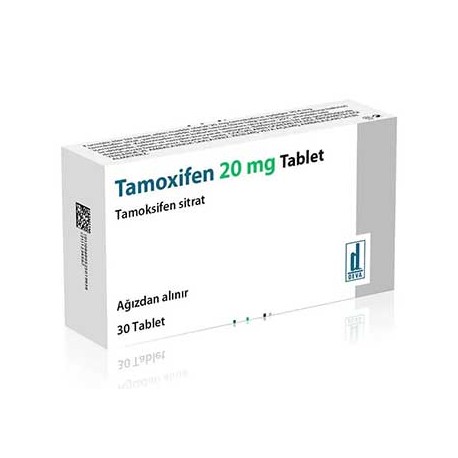No products
 View larger
View larger Volume discounts
| Quantity | Price | You Save |
|---|---|---|
| 2 | $32.00 | Up to $2.56 |
| 3 | $32.00 | Up to $7.68 |
| 4 | $32.00 | Up to $15.36 |
| 5 | $32.00 | Up to $25.60 |
More info
1. NAME OF THE MEDICINAL PRODUCT
TAMOXIFEN 10 mg tablet
2.QUALITATIVE AND QUANTITATIVE COMPOSITION
Active ingredient:
Tamoxifen citrate (equivalent to 10 mg tamoxifen)………….15.2 mg
Excipients:
Lactose (produced from cow's milk)…………. 114.4 mg
For excipients see 6.1
3. PHARMACEUTICAL FORM
film tablet
White, round tablets
4. CLINICAL FEATURES
4.1 Therapeutic Indication
TAMOXIFEN is indicated for the treatment of breast cancer.
4.2 Posology and method of administration
Posology/application frequency and duration
Adults and elderly: Twice daily in divided doses or once daily as a single dose.
As a daily dose, 20-40 mg is administered.
It is recommended that hormonal treatment continue for at least 5 years in early stage breast cancer.
The optimum TAMOXIFEN treatment duration is left to the physician's determination.
Method of Application
It is used orally.
Additional information regarding special populations:
Kidney/Liver failure:
There is not enough information.
Pediatric population:
Since its effect and safety have not been proven, its use in children is not recommended (see Pharmacodynamic properties and 5.2 Pharmacokinetic properties).
Geriatric population: No dose modification is recommended in the elderly.
4.3 Contraindications
Pregnancy: TAMOXIFEN should not be used during pregnancy. A very small number of miscarriages, fetal deaths and birth defects have been reported in women using tamoxifen, but a causal relationship between these cases and drug use has not been established (see Section 4.6 Pregnancy and Lactation).
It should not be used in those with known hypersensitivity to TAMOXIFEN or any of its ingredients. Its use together with anastrazole is contraindicated.
4.4 Special usage warnings and precautions
Menstruation is suppressed in some patients who take TAMOXIFEN for the treatment of breast cancer and who have not reached menopause.
An increased incidence of endometrial changes such as hyperplasia, polyps, endometrial cancer, and uterine sarcoma (mostly malignant mixed Müllerian tumors) has been reported in association with tamoxifen treatment. The underlying mechanism is unknown, but it may be related to the estrogen-like effect of TAMOXIFEN. Any patient who is continuing to be treated with TAMOXIFEN or who has previously been treated with TAMOXIFEN reports abnormal gynecological symptoms, particularly signs of vaginal bleeding or menstrual irregularities and vaginal discharge such as pain or pressure in the pelvis, the patient should be evaluated immediately.
It is recommended that patients undergo gynecological check-ups before the use of the drug in question and periodically throughout the treatment and to report any abnormal vaginal bleeding to their doctor. In clinical trials with breast cancer patients, following treatment with tamoxifen, some
A second primary tumor formation in a region other than the endometrium and other breast has been reported in patients. No causal relationship between these observations and tamoxifen has been identified, and its clinical significance has not been elucidated.
When used several times the normal dose, TAMOXIFEN may cause the development of long QT syndrome / Torsades de Pointes. Congenital long QT syndrome or Torsades de Pointes
It should not be used in patients with a known or suspected diagnosis.
Venous thromboembolism (VTE)
In healthy women given tamoxifen, a 2- to 3-fold increased risk of thromboembolism has been observed (see section 4.8 Undesirable effects).
In breast cancer patients, information about the patient's personal and family history of thromboembolism should be carefully obtained before prescribing medication. If a prothrombotic risk is determined, patients should be screened for thrombophilic factors. test result
Patients who are positive should be warned about thrombotic risk. The decision regarding the use of tamoxifen in such patients should be made based on the overall risk to the patient. Concomitant use of tamoxifen with prophylactic anticoagulants may be considered in some patients (see section 4.5).
cross reference). Severe obesity further increases the risk of VTE by increasing age and all other risk factors. The risk-benefit balance should be evaluated in all patients before initiating treatment with tamoxifen.
should be evaluated carefully. In patients with breast cancer, concomitant chemotherapy also increases the risk (see section 4.5 Interaction with other medicinal products and other forms of interaction).
Long-term anticoagulant prophylaxis may be considered in patients with multiple risk factors for VTE. Surgery and immobilization: In patients treated for infertility, tamoxifen use should be stopped at least 6 weeks before surgery or prolonged immobilization (if possible) and restarted only when the patient is fully mobile. In breast cancer patients, however, the risk of thrombosis induced by tamoxifen is greater than the risk due to treatment interruption.
If clearly greater, tamoxifen treatment should be stopped. Appropriate prophylactic measures for thrombosis should be taken for all patients and should be monitored during their stay in the hospital and early in their recovery.
If possible, anticoagulant therapy should be administered, including graduated compression stockings during the period

